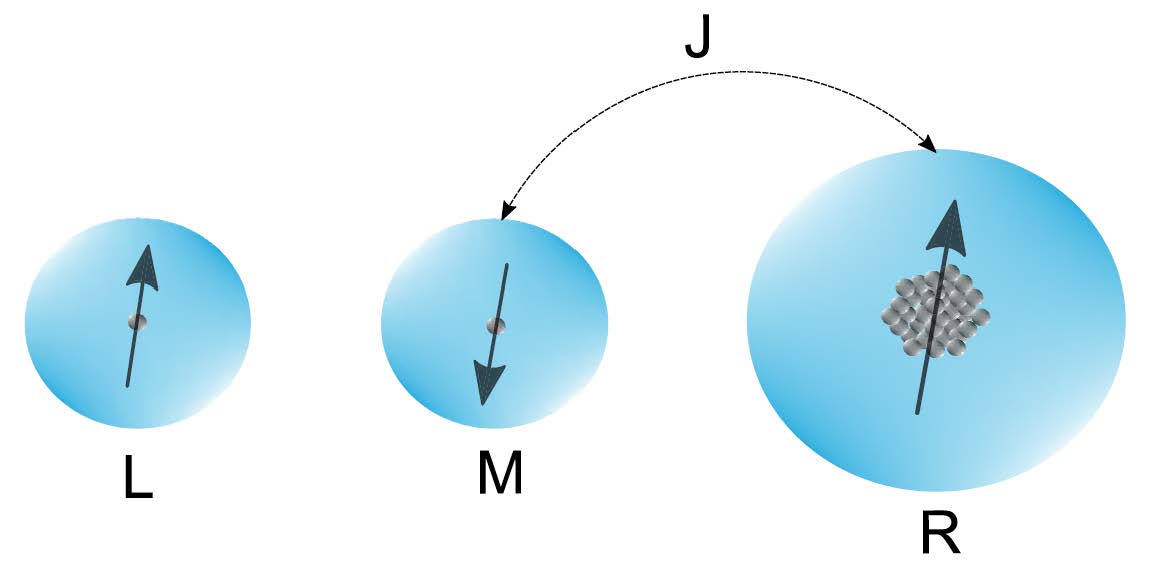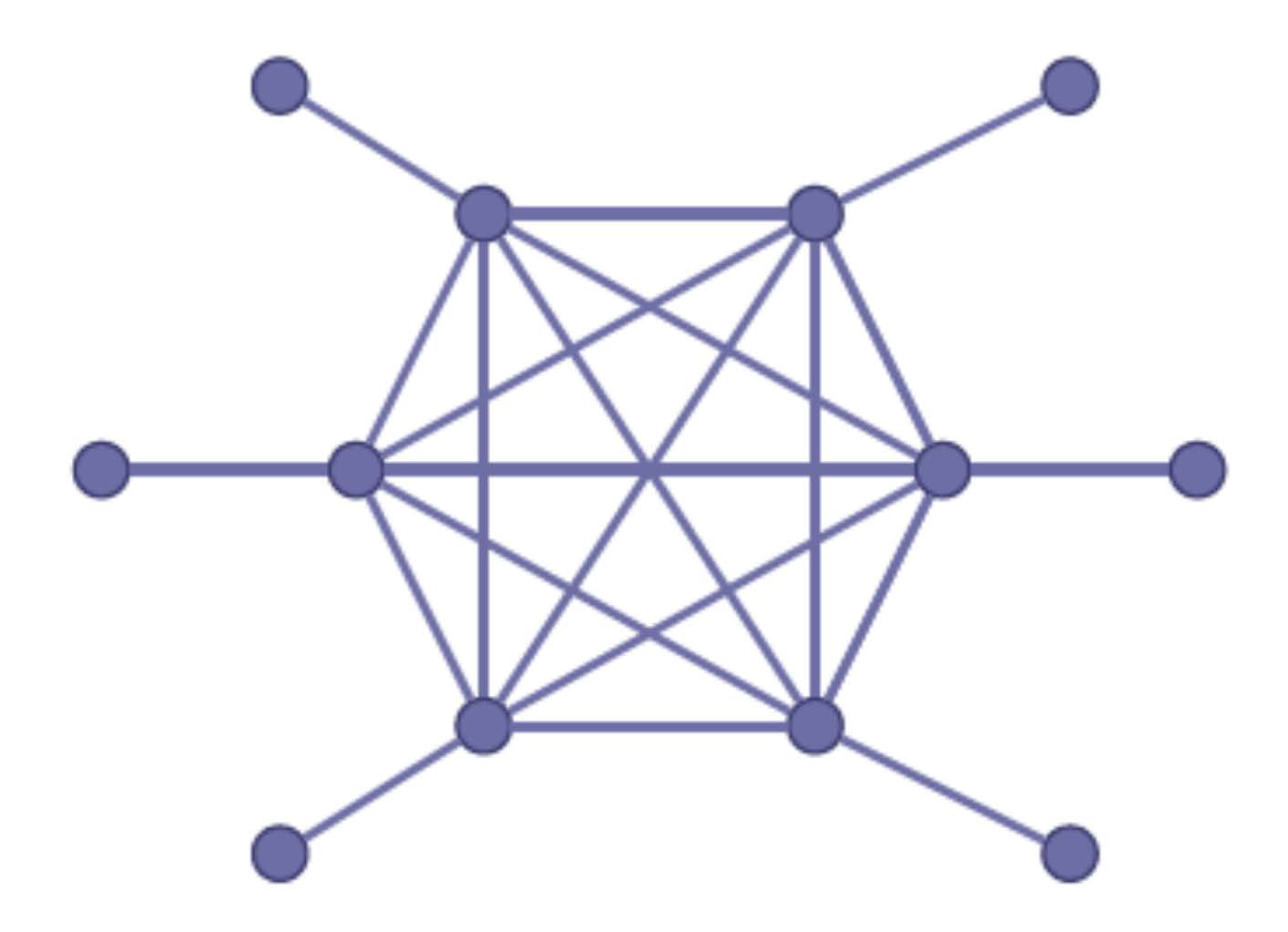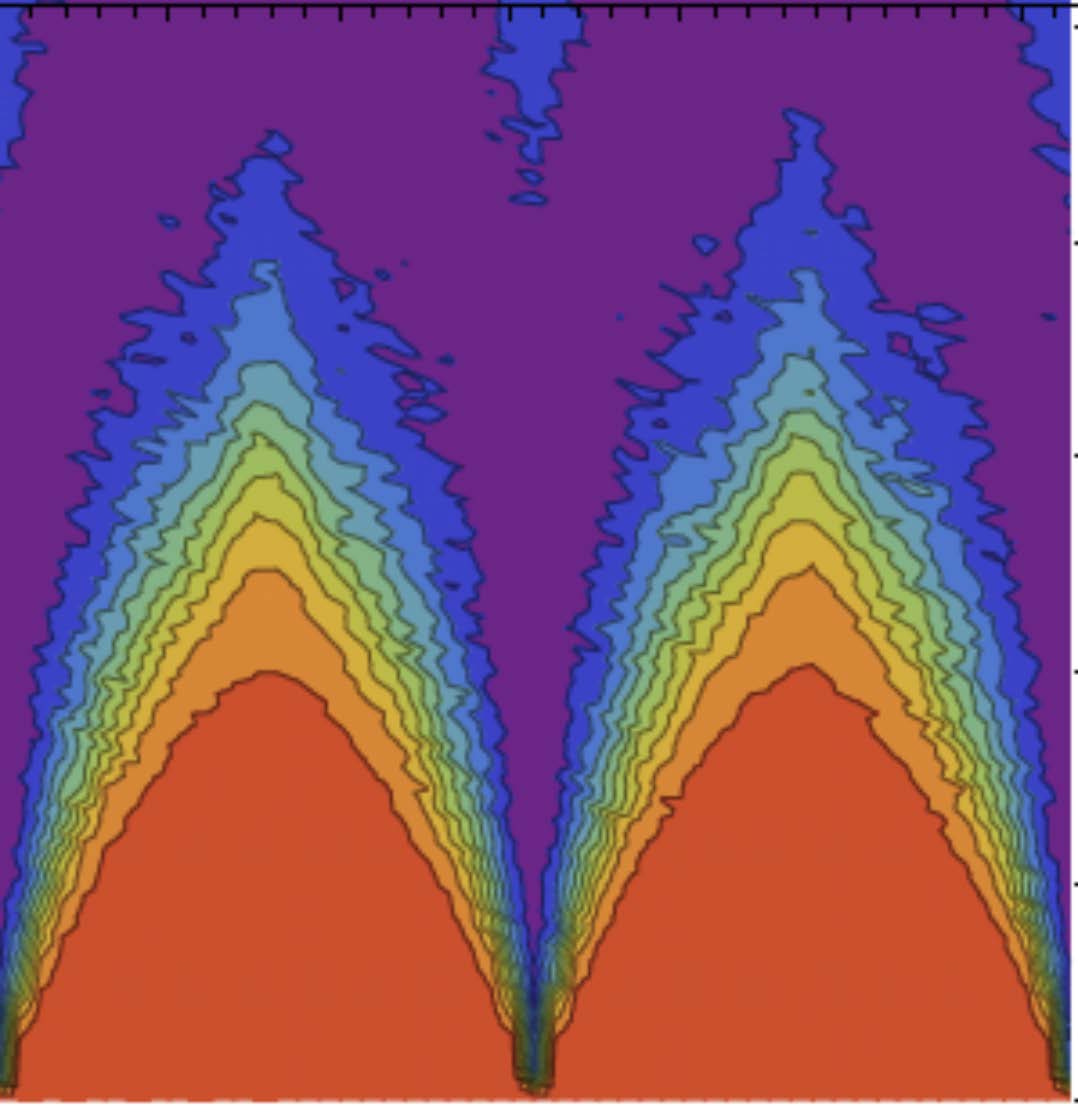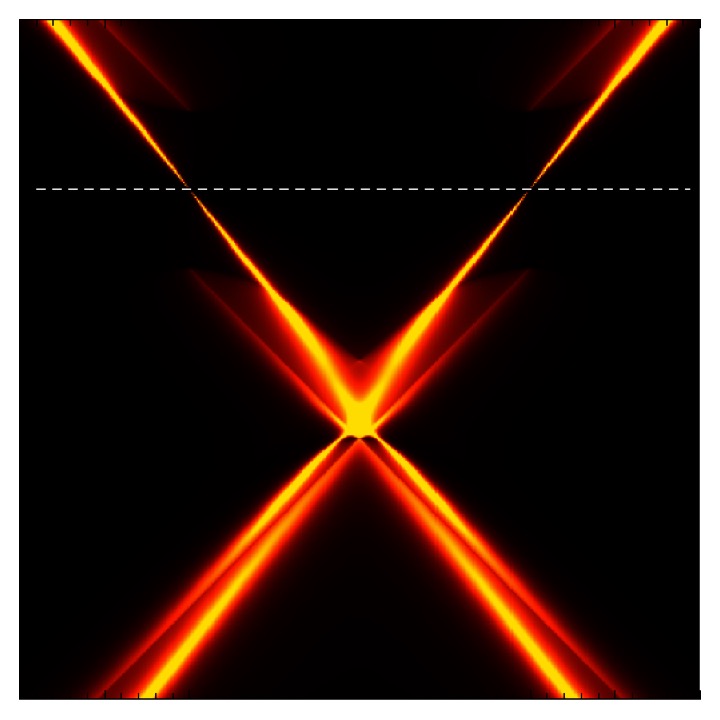Part of the Virginia Tech Center for Quantum Information Science and Engineering (VTQ)
Overview
The overarching goal of our research is to understand how quantum physics can be exploited to develop new technologies that are otherwise impossible. Over the past few decades, it was discovered that quantum physics has the potential to revolutionize information security and sensor technology, in addition to enabling quantum computers, devices capable of solving a number of outstanding problems in physics, chemistry, and biomedicine that are intractable with even the most powerful supercomputers. Recent years have also witnessed the advent of novel quantum materials that can potentially form the foundation for a new era of low-energy electronics. These findings have spurred enormous efforts around the world to bring these quantum information technologies to fruition.
Our research is focused on bridging the gap between abstract theory and experimental reality. Most of the basic principles underlying quantum information technologies are well understood at this point, and the central challenge now is to determine how real physical systems can be identified and developed to realize these technologies in the laboratory despite their imperfections. In the context of information security and quantum computing, the two main challenges are decoherence (the loss of information due to unwanted interactions between a quantum system and its environment) and scalability (can a large number of microscopic quantum systems be connected together and controlled with the requisite precision?). Much of our work is devoted to solving both of these problems for a number of different physical systems that are currently at the forefront of quantum information science research. In the case of quantum materials, our research is centered on discovering and understanding new properties of these materials and how they can be leveraged to create novel devices and new technologies.
Our research group uses a combination of analytical and numerical methods to understand and tackle a range of problems in quantum information science and condensed matter physics. While our work is purely theoretical, we often provide support to experimental groups around the world. Areas of primary focus include the development of control techniques for quantum processors based on semiconductors, molecular systems, or low-temperature superconducting electronic circuits; the development of microscopic models of how quantum systems interact with their environment that can be used to either suppress such interactions or exploit them for technological applications; the study of topological quantum materials and their potential for new types of electronic devices; and the design of protocols that leverage quantum mechanics to achieve secure, long-distance communication and computation.
Spin qubits
 Quantum mechanics offers the potential to revolutionize the way in which information is stored, transferred, and processed. One of the leading platforms for quantum information processing uses the spin degree of freedom of individual electrons or atomic nuclei to encode quantum bits (qubits) of information. Our research on electron spin qubits focuses on the case in which the electrons are confined in nanoscale structures known as quantum dots which can arise at semiconductor interfaces through either strain mismatch or carefully tuned gate electrodes. We also study spin qubits based on either electronic or nuclear spins localized on phosphorous donors in silicon or on single-molecule magnets. While such spin qubits are attractive due to their long-lived quantum coherence and potential for being scaled-up into a quantum computer because of their small scale and their connections to the existing semiconductor industry, they also face several challenges. Chief among these is environmentally-induced decoherence, a problem faced by all solid state qubits. We investigate the properties of this decoherence and work closely with experimentalists to develop methods to reduce its effects. We also work on developing methods to achieve long-distance entanglement between spins using superconducting cavity-mediated interactions. This research is supported by the Army Research Office and the Department of Energy.
Quantum mechanics offers the potential to revolutionize the way in which information is stored, transferred, and processed. One of the leading platforms for quantum information processing uses the spin degree of freedom of individual electrons or atomic nuclei to encode quantum bits (qubits) of information. Our research on electron spin qubits focuses on the case in which the electrons are confined in nanoscale structures known as quantum dots which can arise at semiconductor interfaces through either strain mismatch or carefully tuned gate electrodes. We also study spin qubits based on either electronic or nuclear spins localized on phosphorous donors in silicon or on single-molecule magnets. While such spin qubits are attractive due to their long-lived quantum coherence and potential for being scaled-up into a quantum computer because of their small scale and their connections to the existing semiconductor industry, they also face several challenges. Chief among these is environmentally-induced decoherence, a problem faced by all solid state qubits. We investigate the properties of this decoherence and work closely with experimentalists to develop methods to reduce its effects. We also work on developing methods to achieve long-distance entanglement between spins using superconducting cavity-mediated interactions. This research is supported by the Army Research Office and the Department of Energy.
Quantum control
 Harnessing the power of quantum mechanics and integrating it into new technologies is a long-standing goal in the fields of quantum information and nanoscience. The main obstacle to realizing such quantum technologies is decoherence. In addition to making advancements in the design and fabrication of nanoscale systems, overcoming this problem requires the development of control protocols capable of maintaining or manipulating the quantum information stored in these systems while simultaneously mitigating the deleterious effects of the environment. This task is made challenging by the fact that developing such control protocols requires one to solve the time-dependent Schrodinger equation, which is generally intractable analytically---only a handful of exact solutions have been found since the birth of quantum mechanics almost one hundred years ago. To overcome this problem, we developed a way to construct an infinite number of solutions using a reverse-engineering technique. In addition, we developed a new mathematical framework that allows one to visualize in a simple geometrical way the entire solution space of control protocols that suppress adverse environmental effects. We are using this method to design robust quantum logic gates in a variety of qubit platforms. We have further extended our analytical control techniques to address another type of control problem known as leakage, which can become significant when multiple quantum systems are coupled together. We focus primarily on qubits based on superconducting circuits, because leakage is particularly challenging in these systems. This research is supported by the Army Research Office and the Office of Naval Research.
Harnessing the power of quantum mechanics and integrating it into new technologies is a long-standing goal in the fields of quantum information and nanoscience. The main obstacle to realizing such quantum technologies is decoherence. In addition to making advancements in the design and fabrication of nanoscale systems, overcoming this problem requires the development of control protocols capable of maintaining or manipulating the quantum information stored in these systems while simultaneously mitigating the deleterious effects of the environment. This task is made challenging by the fact that developing such control protocols requires one to solve the time-dependent Schrodinger equation, which is generally intractable analytically---only a handful of exact solutions have been found since the birth of quantum mechanics almost one hundred years ago. To overcome this problem, we developed a way to construct an infinite number of solutions using a reverse-engineering technique. In addition, we developed a new mathematical framework that allows one to visualize in a simple geometrical way the entire solution space of control protocols that suppress adverse environmental effects. We are using this method to design robust quantum logic gates in a variety of qubit platforms. We have further extended our analytical control techniques to address another type of control problem known as leakage, which can become significant when multiple quantum systems are coupled together. We focus primarily on qubits based on superconducting circuits, because leakage is particularly challenging in these systems. This research is supported by the Army Research Office and the Office of Naval Research.
Quantum communication
 Future powerful quantum computers will be capable of running algorithms that can be used to crack the RSA encryption system---the predominant scheme used to protect sensitive data and internet transactions across the world. Although quantum mechanics can be used to compromise information security in this way, it also offers a way to defend against such attacks. The quantum no-cloning theorem, which forbids the copying of unknown quantum states, implies that it is possible to transmit information in a way that makes it impossible to intercept transmissions without being detected. This idea has lead to the notion of quantum communication, which aims to develop communication networks that are immune to hacking, even by large-scale quantum computers. While the no-cloning theorem is the basic principle that makes quantum communication possible, it also poses a challenge. Transmitting information over long distances generally requires that the information be copied and re-amplified at multiple points (repeaters) along the information path due to the lossiness of optical fibers. However, the no-cloning theorem prevents a direct implementation of this idea in the case of quantum information. Quantum entanglement can be used to get around this problem. We are developing schemes to produce complex, entangled states of light for long-distance quantum communication networks. This effort is based on our recent theoretical finding that the complex states needed for distributing information securely across networks can be produced using only a few quantum emitters. We are working with our experimental collaborators to construct and test photonic circuit devices capable of implementing our idea. This research is supported by the National Science Foundation.
Future powerful quantum computers will be capable of running algorithms that can be used to crack the RSA encryption system---the predominant scheme used to protect sensitive data and internet transactions across the world. Although quantum mechanics can be used to compromise information security in this way, it also offers a way to defend against such attacks. The quantum no-cloning theorem, which forbids the copying of unknown quantum states, implies that it is possible to transmit information in a way that makes it impossible to intercept transmissions without being detected. This idea has lead to the notion of quantum communication, which aims to develop communication networks that are immune to hacking, even by large-scale quantum computers. While the no-cloning theorem is the basic principle that makes quantum communication possible, it also poses a challenge. Transmitting information over long distances generally requires that the information be copied and re-amplified at multiple points (repeaters) along the information path due to the lossiness of optical fibers. However, the no-cloning theorem prevents a direct implementation of this idea in the case of quantum information. Quantum entanglement can be used to get around this problem. We are developing schemes to produce complex, entangled states of light for long-distance quantum communication networks. This effort is based on our recent theoretical finding that the complex states needed for distributing information securely across networks can be produced using only a few quantum emitters. We are working with our experimental collaborators to construct and test photonic circuit devices capable of implementing our idea. This research is supported by the National Science Foundation.
Many-body localization and time crystals
 Most interacting quantum many-body systems will act like their own thermal baths in the sense that any subsystem will approach thermal equilibrium on long timescales, erasing any memory of the initial state. However, in recent years a number of interacting systems have been shown to violate this expectation, even in the presence external driving, which one would naively expect to cause heating and eventually the formation of a thermal state. Some of the phases which exhibit this type of behavior are known as many-body localization and time crystals. We are interested in better understanding when such phases arise and how they can be used to enhance the coherence times of qubits. We primarily investigate spin chain models to answer these questions, and we collaborate closely with experimental groups working on spin chains in semiconductor quantum dot arrays to realize these phases in the laboratory. We have shown that signatures of many-body localization are evident in arrays containing as few as four spins, and that these signatures can be detected using existing experimental techniques, including measurements of singlet-return probabilities via spin-to-charge conversion. We have also shown that applying periodic driving to such a system can create a discrete time crystal phase in which the array of spins periodically returns to its initial state despite the presence of spin-spin coupling, control errors, and local disorder. We are working to exploit this behavior to extend the coherence times of the spin array for the purpose of quantum information processing. This research is supported by the Defense Advanced Research Projects Agency.
Most interacting quantum many-body systems will act like their own thermal baths in the sense that any subsystem will approach thermal equilibrium on long timescales, erasing any memory of the initial state. However, in recent years a number of interacting systems have been shown to violate this expectation, even in the presence external driving, which one would naively expect to cause heating and eventually the formation of a thermal state. Some of the phases which exhibit this type of behavior are known as many-body localization and time crystals. We are interested in better understanding when such phases arise and how they can be used to enhance the coherence times of qubits. We primarily investigate spin chain models to answer these questions, and we collaborate closely with experimental groups working on spin chains in semiconductor quantum dot arrays to realize these phases in the laboratory. We have shown that signatures of many-body localization are evident in arrays containing as few as four spins, and that these signatures can be detected using existing experimental techniques, including measurements of singlet-return probabilities via spin-to-charge conversion. We have also shown that applying periodic driving to such a system can create a discrete time crystal phase in which the array of spins periodically returns to its initial state despite the presence of spin-spin coupling, control errors, and local disorder. We are working to exploit this behavior to extend the coherence times of the spin array for the purpose of quantum information processing. This research is supported by the Defense Advanced Research Projects Agency.
Quantum simulation
 While the simulation of quantum systems on today's classical computers has been tremendously successful, large, strongly correlated quantum systems remain far beyond the reach of the world's best supercomputers. This is due to the inability of classical machines to store or manipulate exponentially large quantum states. The concept of digital quantum simulation proposes to circumvent this problem by replacing the classical computer with a programmable quantum processor built from qubits. Quantum simulation is believed to be one of the most near-term applications of quantum information science in that a modest-sized quantum processor containing as few as 50-100 qubits may be sufficient to simulate systems that are classically intractable. Realizing this potential requires simultaneous advancements in qubit hardware and in simulation algorithms. Our research focuses on developing new, efficient algorithms for quantum simulation that reduce the number of qubits and the number of logic gates needed to extract the desired information from the system being simulated such as energy eigenvalues and eigenstates. We also work closely with experimental groups to determine the control schemes and device architectures that are optimal for achieving efficient, accurate simulations. This research is supported by the National Science Foundation and the Department of Energy.
While the simulation of quantum systems on today's classical computers has been tremendously successful, large, strongly correlated quantum systems remain far beyond the reach of the world's best supercomputers. This is due to the inability of classical machines to store or manipulate exponentially large quantum states. The concept of digital quantum simulation proposes to circumvent this problem by replacing the classical computer with a programmable quantum processor built from qubits. Quantum simulation is believed to be one of the most near-term applications of quantum information science in that a modest-sized quantum processor containing as few as 50-100 qubits may be sufficient to simulate systems that are classically intractable. Realizing this potential requires simultaneous advancements in qubit hardware and in simulation algorithms. Our research focuses on developing new, efficient algorithms for quantum simulation that reduce the number of qubits and the number of logic gates needed to extract the desired information from the system being simulated such as energy eigenvalues and eigenstates. We also work closely with experimental groups to determine the control schemes and device architectures that are optimal for achieving efficient, accurate simulations. This research is supported by the National Science Foundation and the Department of Energy.
Topological materials
 Our research includes the investigation of quantum materials that have potential technological applications, including two-dimensional materials that couple strongly to light and topological materials that can carry low-loss electrical currents on their surface or edge. The former have potential applications that include photodetectors, light-emitting diodes, and solar cell devices, while the latter are relevant for future, low-dissipation electronics. Materials known as Dirac or Weyl semimetals possess a bulk band structure in which the conduction and valence bands meet at isolated points in the Brillouin zone known as Dirac or Weyl nodes. The best known example is graphene, a two-dimensional sheet of hexagonally arranged carbon atoms. In the last few years, the first three-dimensional materials exhibiting Dirac/Weyl nodes have been discovered; these include compounds such as Na3Bi, Cd3As2, and TaAs. The existence of Dirac/Weyl nodes can lead to low-energy excitations which behave as massless, quasirelativistic fermions, giving rise to a strongly interacting version of quantum electrodynamics in the solid state. In three dimesions, Dirac/Weyl nodes also give rise to topologically protected surface states and exotic transport driven by the chiral anomaly, an unusual quantum mechanical effect first discovered in high-energy physics. We study non-equilibrium processes in topological materials, the role of Fermi arc surface states in Weyl semimetal transport, and the electromagnetic signatures of the chiral anomaly. This research is supported by the National Science Foundation.
Our research includes the investigation of quantum materials that have potential technological applications, including two-dimensional materials that couple strongly to light and topological materials that can carry low-loss electrical currents on their surface or edge. The former have potential applications that include photodetectors, light-emitting diodes, and solar cell devices, while the latter are relevant for future, low-dissipation electronics. Materials known as Dirac or Weyl semimetals possess a bulk band structure in which the conduction and valence bands meet at isolated points in the Brillouin zone known as Dirac or Weyl nodes. The best known example is graphene, a two-dimensional sheet of hexagonally arranged carbon atoms. In the last few years, the first three-dimensional materials exhibiting Dirac/Weyl nodes have been discovered; these include compounds such as Na3Bi, Cd3As2, and TaAs. The existence of Dirac/Weyl nodes can lead to low-energy excitations which behave as massless, quasirelativistic fermions, giving rise to a strongly interacting version of quantum electrodynamics in the solid state. In three dimesions, Dirac/Weyl nodes also give rise to topologically protected surface states and exotic transport driven by the chiral anomaly, an unusual quantum mechanical effect first discovered in high-energy physics. We study non-equilibrium processes in topological materials, the role of Fermi arc surface states in Weyl semimetal transport, and the electromagnetic signatures of the chiral anomaly. This research is supported by the National Science Foundation.